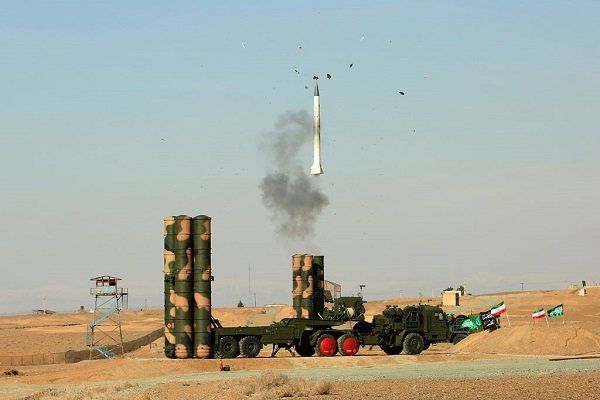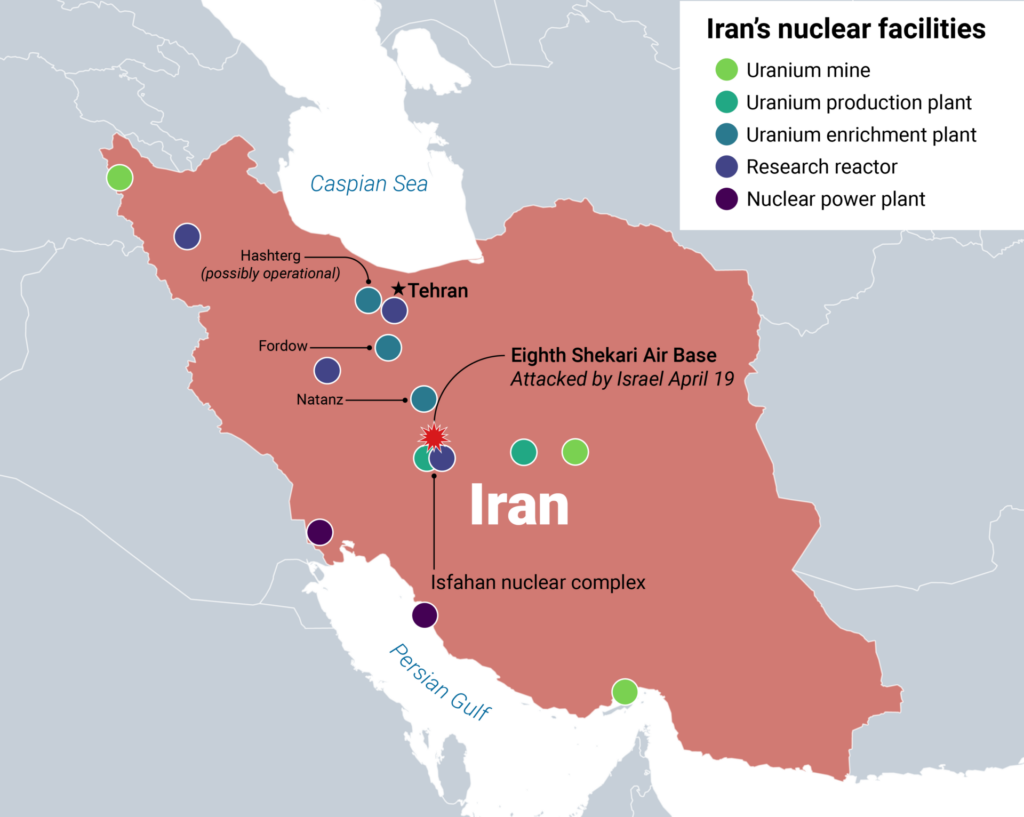Why Iran may accelerate its nuclear program, and Israel may be tempted to attack it
By Darya Dolzikova, Matthew Savill | April 26, 2024
 Israel's April 19 strike on the Eighth Shekari Air Base in Iran reportedly damaged a S-300 missile defense system (shown here during a test in 2017) deployed to protect the nearby nuclear sites. (Credit: Still shot from Rasane TV)
Israel's April 19 strike on the Eighth Shekari Air Base in Iran reportedly damaged a S-300 missile defense system (shown here during a test in 2017) deployed to protect the nearby nuclear sites. (Credit: Still shot from Rasane TV)
On April 19, Israel carried out a strike deep inside Iranian territory, near the city of Isfahan. The attack was apparently in retaliation for a major Iranian drone and missile attack on Israel a few days earlier. This exchange between the two countries—which have historically avoided directly targeting each other’s territories—has raised fears of a potentially serious military escalation in the region.
Israel’s strike was carried out against an Iranian military site located in close proximity to the Isfahan Nuclear Technology Center, which hosts nuclear research reactors, a uranium conversion plant, and a fuel production plant, among other facilities. Although the attack did not target Iran’s nuclear facilities directly, earlier reports suggested that Israel was considering such attacks. The Iranian leadership has, in turn, threatened to reconsider its nuclear policy and to advance its program should nuclear sites be attacked.
These events highlight the threat from regional escalation dynamics posed by Iran’s near-threshold nuclear capability, which grants Iran the perception of a certain degree of deterrence—at least against direct US retaliation—while also serving as an understandably tempting target for Israeli attack. As tensions between Israel and Iran have moved away from their traditional proxy nature and manifested as direct strikes against each other’s territories, the urgency of finding a timely and non-military solution to the Iranian nuclear issue has increased.
A tempting target. While the current assessment is that Iran does not possess nuclear weapons, the Islamic Republic maintains a very advanced nuclear program, allowing it to develop a nuclear weapons capability relatively rapidly, should it decide to do so. Iran’s “near-threshold” capability did not deter Israel from undertaking its recent attack. But Iran’s nuclear program is a tempting target for an attack that could have potentially destabilizing ramification: The program is advanced enough to pose a credible risk of rapid weaponization and at a stage when it could still be significantly degraded, albeit at an extremely high cost.
Iran views its nuclear program as a deterrent against direct US strikes on or invasion of its territory, acting as an insurance policy of sorts against invasion following erroneous Western accusations over its nuclear program, ala Iraq in 2003. That’s to say, during an attempted invasion, Iran could quickly produce nuclear weapons. This capability allows Iran’s leadership to engage in destabilizing activities in the region with a (perceived) limited likelihood of retaliation against its own territory. Concerns over escalation and a potential Iranian push toward weaponization of its nuclear program may have been one of multiple considerations that contributed to the US refusal to take part in Israeli retaliatory action following Iran’s April 13 strikes on Israel.
Israel sees the Iranian nuclear program as an existential threat and has long sought its elimination. For this reason, reports that Israel might have been preparing to target Iranian nuclear sites as retaliation for Iran’s strikes against its territory came as little surprise. Israel’s attack on military installations near Iranian nuclear facilities—and against an air defense system that Iran has deployed to protect its nuclear sites—appears to have been calibrated precisely to make the point that Israel has the capability to directly attack heavily-protected nuclear sites deep inside Iran. Some commentators have speculated that subsequent strikes on Iranian nuclear sites may still be desirable or necessary.

In this context, Iran’s nuclear sites will continue to present a tempting target for Israel in any further escalation of the conflict between the two. Moreover, Israel may also conclude that its own undeclared nuclear capability has failed to act as a deterrent against two major assaults on its territory. The attacks by Hamas on October 7 and Iran on April 13 probably added to Israel’s sense of strategic vulnerability, although that perception may have been partly alleviated by the largely successful defense against Iran’s attempted drone and missile strikes.
Israel has historically targeted Iran’s nuclear program through relatively limited sabotage in the form of cyber-attacks, assassinations of scientists, and bombs placed at Iranian nuclear facilities. This strategy has allowed Israel to repeatedly roll the clock back on Iran’s nuclear progress while maintaining some level of credible deniability and avoiding further military escalation, therefore largely remaining within the “rules” established by Israel and Iran in conducting their shadow war. Now, with both countries openly striking each other’s territory, Israel may see this as an opportunity—or feel compelled—to target Iran’s nuclear facilities directly.
A range of bad options. The possibility of Iranian weaponization and Israeli attacks on Iran’s nuclear sites could lead to a serious escalation spiral and, potentially, a wider military conflict in the region.
Should Iran anticipate that Israel is preparing to carry out strikes against its nuclear sites, it may decide to rush toward producing a nuclear weapon before Israel has the time to inflict any significant damage on its ability to do so quickly. In turn, expecting an anticipatory push toward weaponization by Tehran, Jerusalem may be incentivized to carry out strikes to pre-empt Iran from acquiring a nuclear weapon. The disparity in timelines here favors Israel and creates risk for Iran: The former could attempt a strike in a short period—maybe days or weeks—whereas it would probably take Iran several months to a year from the point of decision to have a viable weapon, although estimates remain uncertain. Yet, through the advanced state of its nuclear program, Iran may be able to make significant advances toward a deployable nuclear weapon before the International Atomic Energy Agency (IAEA)—or indeed, Israeli intelligence—catches on to developments, which would limit the time Israeli planners would have to mount a pre-emptive response.
Tehran may make the decision to build nuclear weapons in response to a limited Israeli strike on its nuclear facilities. The Iranian nuclear complex is too dispersed, key facilities too hardened, and nuclear expertise too consolidated to be eliminated through limited military strikes. Iran’s uranium enrichment facilities at Natanz and Fordow, where Iran produces the fissile material needed to produce nuclear weapons, are either fully (in the case of the enrichment facility at Fordow) or partially (at Natanz) underground and are heavily defended. Any Israeli strike that would cause damage to other Iranian nuclear sites—such as its centrifuge production or uranium conversion facilities, or even the not-yet-operational Khonab heavy water research reactor—would set the program back but would ultimately leave Iran with the ability to keep ramping up its uranium enrichment, potentially moving toward the production of weapons-grade uranium (enriched to 90 percent uranium 235). Any work Iran may be currently conducting to weaponize its nuclear technology—even as the US intelligence community assesses it is not doing so—would probably be performed in dispersed and undisclosed locations, making military targeting very challenging.
Following past instances of Israeli sabotage against the Iranian nuclear program, Tehran has doubled down—rebuilding damaged sites, hardening facilities, and ramping up its nuclear activity. The same is likely to be true should Iranian facilities be targeted directly this time, only to a greater degree. The shift from a proxy conflict between Iran and Israel to a direct engagement will only increase the value Iran places on its nuclear program as a deterrent against further direct attack on its territory and US military intervention. Should Iran assess that its regional proxies and its missile and drone capabilities have been insufficient to deter Israel from conducting direct strikes against its strategically significant nuclear program, Tehran may see the actual weaponization of its nuclear program as the only option left that can guarantee the security of the Iranian regime.
Unfortunately, an Israeli attack on non-nuclear Iranian assets may lead the Iranian leadership to reach a similar conclusion. As others have discussed elsewhere, since the Hamas attack on Israel on October 7, Iran’s weaknesses in deterring aggression against its assets in the region and capitalizing on the ongoing instability to advance its own security priorities have become apparent. Such weaknesses may be increasing the perceived strategic value of its nuclear program to Iranian leadership.
Short of developing a full nuclear weapons capability, Iran may first respond by enriching uranium to weapons-grade levels. While weapons-grade uranium alone is not enough to produce a nuclear weapon, it would be a decisive step in that direction. Iran may also retaliate for further Israeli attacks by withdrawing from the Nuclear Non-Proliferation Treaty (NPT). A withdrawal would be followed by the exclusion of IAEA inspectors from the country. Although Iran has significantly restricted inspector access in recent years, the IAEA continues to monitor and report on key aspects of the Iranian nuclear program. An Iranian withdrawal from the NPT would leave the international community with no visibility of developments in the program apart from national intelligence collection or satellite imagery.
Such uncertainty—and a formal reneging of Iran’s commitment under the NPT to forego a nuclear weapons capability—risk seriously exacerbating regional instability. An Iranian withdrawal from the NPT may also incentivize nuclear proliferation in the region, with Saudi Arabia having previously threatened to acquire nuclear weapons if Iran does.
All or nothing. The counterproductive effect of a limited strike on Iran’s nuclear program could lead Israel to consider a large-scale military operation to set the program back as decisively as possible. This option, however, would almost certainly result in an all-out, highly-destructive war between Iran and Israel, probably dragging other regional factions, the United States, and possibly others into the conflict.
To meaningfully roll back the Iranian nuclear program with a military operation, strikes would need to be carried out on facilities spread out across Iranian territory and would require the suppression of Iranian (and possibly Syrian) air defenses. The operation would also need attacks on ballistic missile and other military sites to be carried out, as they might otherwise be used in any immediate Iranian response. Attacks on underground facilities at Fordow and Natanz would require the use of weapons capable of penetrating several dozen meters of rock and reinforced concrete before exploding inside the facilities. The only conventional weapon that could plausibly achieve this is the American GBU-57A/B Massive Ordnance Penetrator, which—with over 12 metric tons and 6 meters long—can only be carried by large US bombers like the B-2 Spirit.
This tactical reality and the scale of the force required to hit so many targets nearly simultaneously suggest that a successful strike against the bulk of Iran’s nuclear program would require extensive US support, if not direct involvement. Even this sort of attack—which would inflict severe violence across Iranian territory—would not guarantee total destruction of Iran’s nuclear program.
In a more optimistic reading of current dynamics, Iran and Israel—recognizing the risks and drawbacks of limited or extensive strikes against Iran’s nuclear program—could help prevent precisely such an escalation. Both Israeli and Iranian leaderships could seek to find ways out of the retaliatory cycle while still being able to claim victory. Indeed, such de-escalating dynamics appear to be playing out, with Israel’s having responded in a limited and measured way to the earlier Iranian strikes on its territory and Iran downplaying the impact of Israel’s attacks. The desire to keep the situation from escalating further also clearly appears in US statements that draw a limit on its willingness to be involved in any attacks on Iran.
US political dynamics remain in the background, however. Should Donald Trump be re-elected to the US Presidency later this year, the Israeli position may harden, as a Republican administration is more likely to support an Israeli attack on the Iranian nuclear program and Trump allies have already called for such strikes. With US support, Israel may feel it has the military and political backing it needs to strike a decisive blow to the Iranian nuclear program and weather the consequences before Iran decides to weaponize.
Managing risks of escalation. Recent events—and whatever further retaliatory measures that follow—are likely to lead to an inflection point in the Iranian nuclear program, as Iran looks to maintain and rebuild whatever deterrent it feels it is lacking or has lost. Meanwhile, the program will continue to be a tempting target for Israel and a source of escalation risks.
The United States, which retains some leverage over Israel, could help reduce these risks significantly by continuing to pressure Israel to keep its retaliation proportionate and limited to non-nuclear assets. Washington should also continue to make it clear that it will not get directly involved in any offensive Israeli military operation and that it will place conditions on any future military support to Israel in its conflict with Iran.
However, even such a measured approach will only act as a palliative treatment to the enduring problem of Iran’s nuclear program. The current situation serves as a sobering reminder of the delicate balance between the deterrent power and destabilizing impact that even a near-threshold nuclear capability can provide. This reality further illustrates the inevitability—and urgency—of finding a negotiated, non-military solution to the Iran nuclear issue. To be sure, the circumstances and conditions for a return to negotiations look as unfavorable as at any point in the last decade. Yet, they are far more desirable than the alternative: Gambling with the risk that Iran’s current advanced nuclear capability may be replaced by the even more destabilizing specter of a deployable nuclear weapon.
Together, we make the world safer.
The Bulletin elevates expert voices above the noise. But as an independent nonprofit organization, our operations depend on the support of readers like you. Help us continue to deliver quality journalism that holds leaders accountable. Your support of our work at any level is important. In return, we promise our coverage will be understandable, influential, vigilant, solution-oriented, and fair-minded. Together we can make a difference.
















An ounce of prevention is a ton of cure. The only threat that would possibly stop the Iranian regime from its nuclear program, is a credible threat of regime change.
If there ever was a legitimate cause for war, then it is to stop Iran from going nuclear. A nuclear Iran would mean a nuclear arms race across the Middle East and beyond. This can end Western civilization as we know it.
If an attack on the Iranian nuclear facilities cannot stop their nuclear program, then regime change is the required route.
Now is not the time for pacifism.
This is a very helpful piece, but please consider: This is not a dynamic between two interchangeable states (A and B). Iran is driven by an Islamist ideology to restore the Caliphate. It is expansionist and has stated its goal (since before ’79) to destroy Israel. Israel has no such designs on Iran, and prior to ’79 Israel (and the Jews) had good relations with Iran and the Persians. The more we mask Iran’s fundamental intentions, the less equipped we are to discuss, meaningfully, the threats being posed. Like the Soviets (and Nazi Germany), Iran is not a “rational actor.”… Read more »
One should also factor in the effect of Libya having given up its nuclear program and the resulting intervention of NATO in the civil strife before the fall of Ghaddafi. As indeed, Iraq having given up its nuclear ambitions and then consequently getting invaded, taking away the former Arab bulwark against Iranian interventionist policies. It’s helpful, in the light of the pro-proliferation policies of the US thus shown – that a nuclear program is an active deterrent against imperial interventionism – to consider the pro-proliferation effect of a US intervention in Bangladesh’s independence war, as described in Garthoff’s “Détente and… Read more »